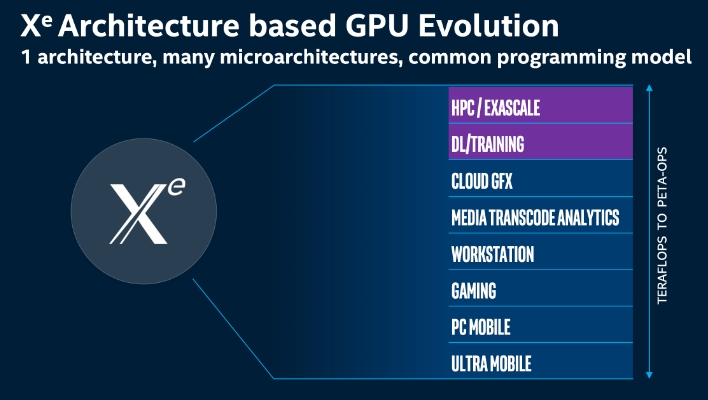Intel's First Discrete GPU For Supercomputers Is 7nm Ponte Vecchio Leveraging Foveros

Intel says that this first discrete GPU instantiation of Ponte Vecchio will be positioned to tackle HPC modeling and simulation workloads along with AI training, with high double-precision Floating Point compute throughput. If that sounds familiar, it's the same market that companies like AMD and NVIDIA are targeting with their Radeon Instinct and Tesla families of GPU accelerators. NVIDIA especially has a major foothold on GPUs in data center markets and will be a strong incumbent force to try and unseat.

Interestingly, Ponte Vecchio -- and not one of its CPUs -- will be Intel's first 7nm product. Rather than using a single monolithic die as we've seen in traditional GPU designs from NVIDIA and AMD, Intel is going with a Multi-Chip Module (MCM) arrangement that ties in multiple chiplets with a high-speed interconnect (think similar to AMD's Zen chiplet design tied together with Infinity Fabric). This is what is going to allow Intel to scale Xe to meet the performance needs of multiple product segments from the low- to high-end. The smaller chips size also plays more favorably for Intel to improve yields at the 7nm node.

Intel will be employing a combination of both its Foveros 3D packaging EMIB (Embedded Multi-die Interconnect Bridge) technologies, along with High Bandwidth Memory (HBM) and Compute Express Link (CXL) which will operate over the newly ratified PCIe 5.0 interface and serve as Ponte Vecchio's high speed switch fabric connecting all GPU resources.

Intel is billing Ponte Vecchio as its first exascale GPU, and will be proving its meddle in the U.S. Department of Energy's (DOE) Aurora supercomputer. The supercomputer will employ a topology of six Ponte Vecchio GPUs and two Intel Xeon Scalable processors based on Intel's next generation Sapphire Rapids architecture, along with Optane DC Persistent Memory on a single blade.
Although Intel says that Aurora will be utilizing its oneAPI programming model, specific details for the system and GPU accelerator are otherwise thin. We do know, however, that this powerful new supercomputer is scheduled to arrive in 2021.

